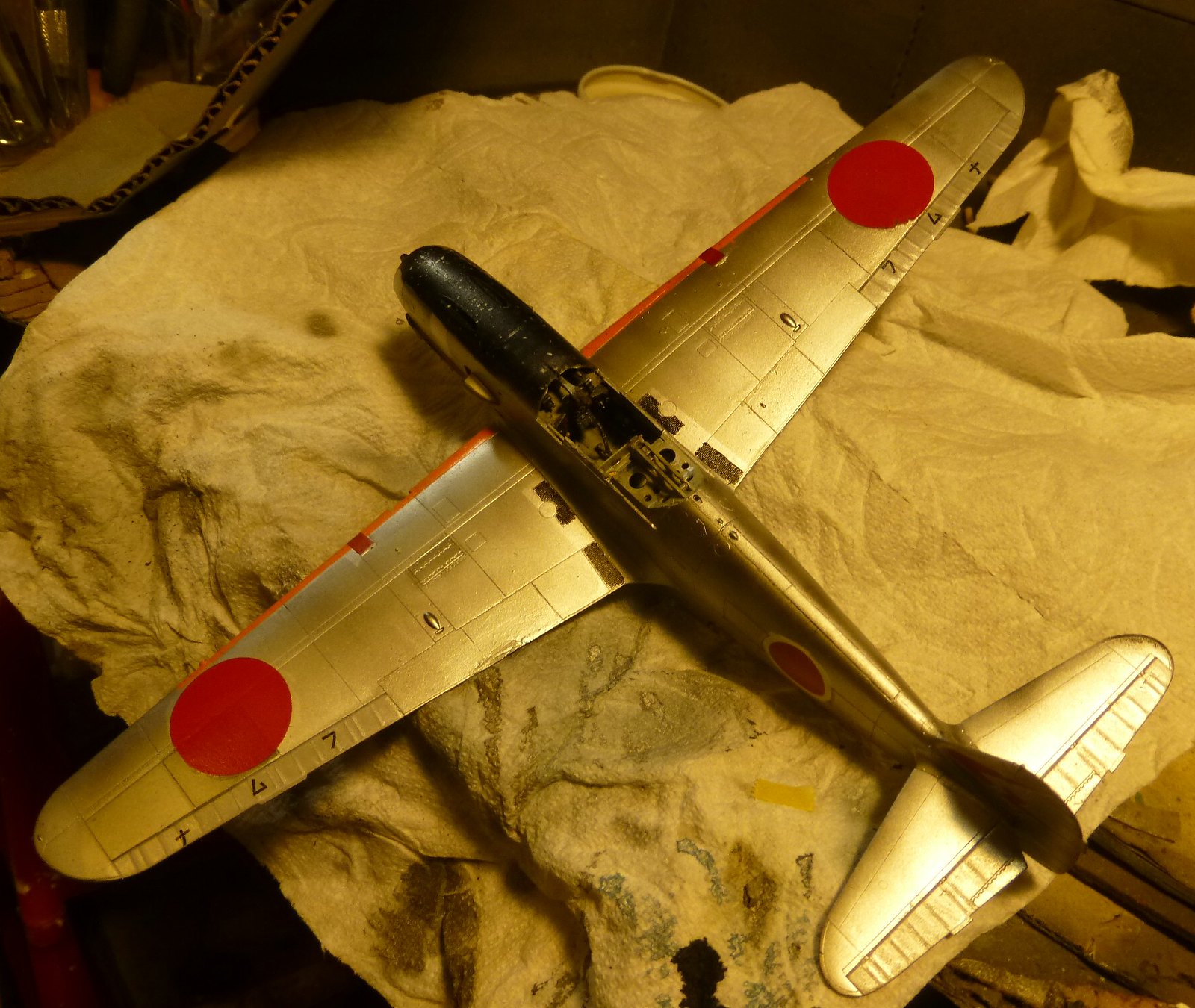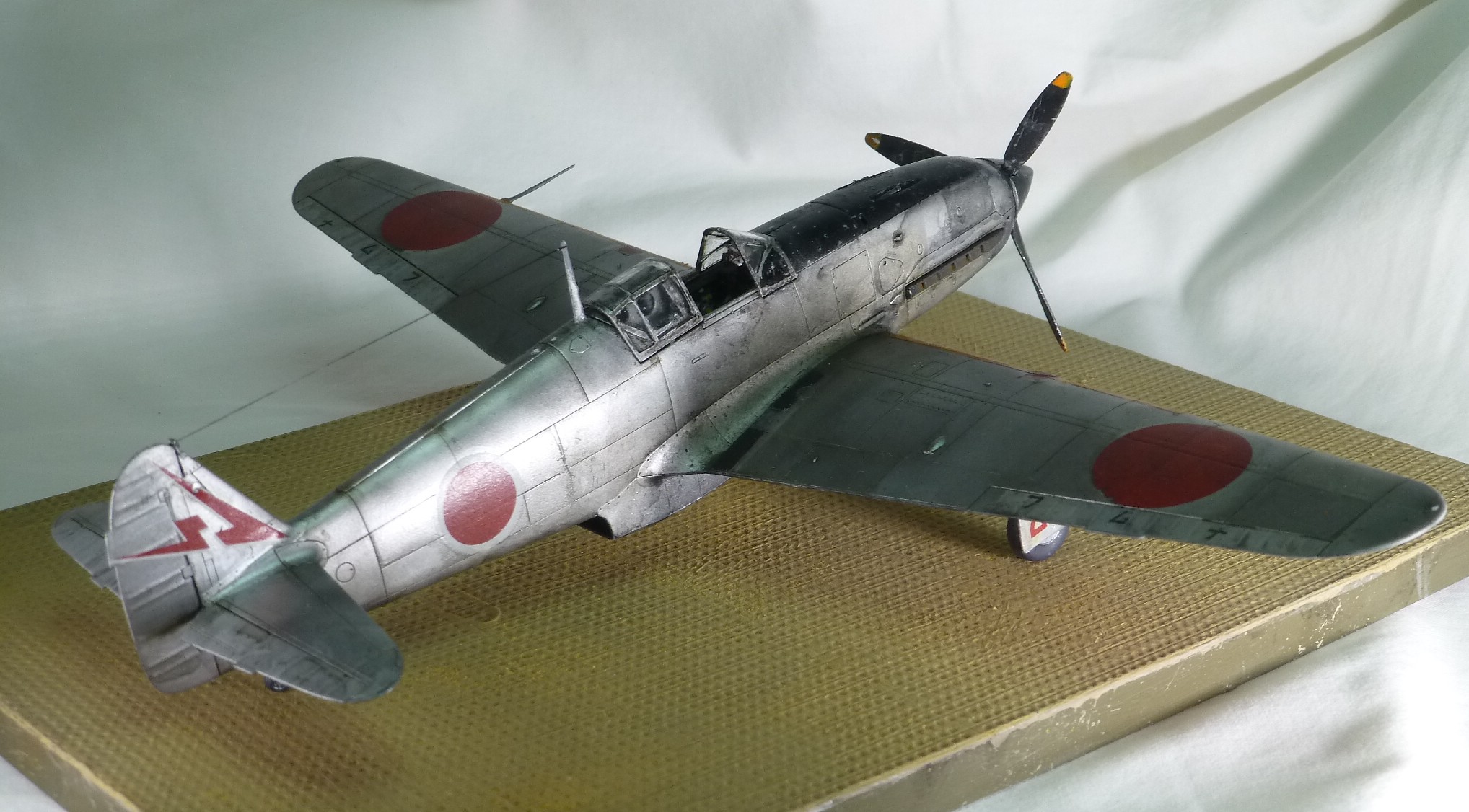Tamiya 1/48 Ki-61-1d
Paints: Vallejo Metal Colors, Golden High Flow Acrylics
Weathering: Oil Wash, Iwata Com.Art Acrylics
Let's call the Tamiya Ki-61 a wrap.
 ki-61met by Eric Bergerud, on Flickr
ki-61met by Eric Bergerud, on Flickr
 rt-iphone by Eric Bergerud, on Flickr
rt-iphone by Eric Bergerud, on Flickr
 tonyprofileview by Eric Bergerud, on Flickr
tonyprofileview by Eric Bergerud, on Flickr
 lft-ft3 by Eric Bergerud, on Flickr
lft-ft3 by Eric Bergerud, on Flickr
In sum, there's no problem with this kit - it was a delight from start to finish. The fit is amazing, the instructions tops and it includes canopy masks and a full scale diagram of the model to help you mask the kit (not needed here, but invaluable in other new Tamiya kits.) Tamiya makes better models than anyone else - the only argument is who is runner up. (Their Christmas kit is a new 1/48 P-38G - there are no tolerable P-38 kits on the market, and this one is supposed to be a stunner.) It doesn't hurt that the Japanese, for the most part, built very handsome planes - and the Ki-61 is a good example.
I was also very impressed with the Vallejo Metal Color Paints. They were very easy to apply and to my eyes are a pigment so fine that it equals the best Gunze metallics. I can't compare it to Alclad or other new lacquers because I can't use lacquers - I'd be looking at a divorce, and I hate the smell of true lacquers also. The Vallejo line are all true water based acrylics and easily worked with. In any case, this means I'll be able to do basically any plane in NMF - a real plus. Might add that the Ki-61 has basically no seams on top or bottom (the plane was derived from the BF-109E - and that aircraft - as Tamiya points out - carries an open seam on top and bottom). The Ki-61 carries a piece over the top rear seam, and the top front seam is supposed to be there. The fit was so good that getting rid of the bottom seams was done almost perfectly. I made one mistake in the build. If you want the cockpit open, you use different parts. When open, the two rear portions pile on top of each other, and that's on top of a well weathered rear cockpit. A closed canopy would have shown the fine clear parts better. (Actually, why do I always build open canopies? There was lots of rain in most WWII theaters, and I'd guess keeping the canopy shut would have been a good idea. Where would a Ki-61 been stationed in 1944? Somewhere near Clark Field in the Philippines would be a good guess - and it rains there a lot.)
The pic below shows the model after plane was painted and the panels muted with different shades of Metal Colors sprayed carefully. It also shows the orange leading edge and a blue/black anti-glare panel. (I put both over salt and which gives them a pretty good chipping to my eyes. Both were Golden High Flow mixes and worked perfectly.) As you can see, I decided to simplify the model's markings. I decided not to employ a black/green mottle and dispensed with the elaborate markings. Actually most photos I found of NMF Ki-61s were pretty bare - large numbers, however, were painted IJAAF green - which closely resembles olive drab. Anyway, I'm sure all of the elaborate decals provided by Tamiya would have looked neat, but I really wanted a clean platform to try out the Metal Colors - this is the first serious NMF plane I've done. (I've got two Oscars in the stash - we'll give one of those a proper green mottle over NMF - that's a lovely aircraft.)
 irregular2 by Eric Bergerud, on Flickr
irregular2 by Eric Bergerud, on Flickr
Weathering went pretty well I think. I knew I didn't want a F-86 type super shine - surely no Japanese combat aircraft ever looked like that, and I doubt many allied did either. That meant I didn't need a super gloss primer. I had some trouble with Stynelrez I used it once thinned and it worked great - this one I tried straight at high PSI as recommended so a little too much got down. When I tried to adjust with sanding, the primer peeled. Fortunately I had my "go to" Duplicolor "Hot Rod Black" automotive "sandable/fillable" primer and fixed it up perfectly well. After giving that a light sand, the effect was a kind of satin black - about perfect for what I wanted. (Note to self- use Duplicolor for all aircraft - I have to go outside to use it, but it's terrific stuff.) Anyway, the first step was to give the plane a light panel line wash using Gamblin and Windsor Newton oils - figure 50/50 black/burnt umber. That's a great wash. I use an extremely mild spirit from Gamblin called Gamsol, and it's terrific. Unfortunately I didn't take a pic. (Should add that I did put some of Vallejo Metal Color Varnish over the model before the weathering. On my paint mule, I found it superior to AK Gauzy. The aim here is to not be visible - that would mess up the metallic effect. I put Vallejo varnish on one wing before the other and couldn't tell the difference. On general principal I did want something between oils and the acrylics.) The last step was a pretty liberal dabbing using Com.Art transparent paints - most smoke (black really), some blue/black smoke and some "old oil." I can't really describe Com.Art to someone who hasn't used it. The paint's really designed for working on paper - hence large numbers of transparent and opaque colors. (I'm sure the opaque colors would stick to Duplicolor - it's almost tempting to try doing a model with them. They're made for airbrushing and do come out splendidly. But my Golden High Flow are so good, that there's no reason to go elsewhere.) For weathering I use a paint brush. Com.Art smoke makes a very good panel wash - faint the way I like it - but the oils worked so well that wasn't necessary. What Com.Art does like no other paint I know is create a grime. If you could see it in person, you can see the kind of sticky texture - reminds one of exhaust or dirt ground into oil. So I sort of dab it on - and try to keep the cover very irregular. I did want a lot more grime from the cockpit forward. Ki-61s were famous for burning oil. I can only assume the wings would have shown that too. Com.Art is also well suited to emulate scuffing from aircrew. (The Japanese never really got its engine to work reliably, even though they had full plans and a working example from Mercedes - Japanese engineers were excellent, but their skills were squandered on an industrial base that couldn't match the quality control found in allied or German planes. That's why both Zeros and Oscars were in production in 1945 - all of the second generation IJ aircraft were "hangar queens" for much of their life. The best Ki-61 was a model mated with a decent radial engine becoming the very fast Ki-100.) I think the photos of wartime Ki-61s above show the extremely untidy finish - especially in the front half of the plane. Below is a detail shot of the front and one of the rear - both show grime, but the second has less.
 det1 by Eric Bergerud, on Flickr
det1 by Eric Bergerud, on Flickr
 det3 by Eric Bergerud, on Flickr
det3 by Eric Bergerud, on Flickr
Below are some more pics of the complete bird. I used different lighting on the pictures. An interesting characteristic of NMF is that the plane changes color dramatically depending upon where light and shadow appear. There are very good color photos of US late war P-47 squadrons on YouTube and the planes appearance varies on every change of angle. And none of the Jugs looks clean and shinny either.
Eric
 lft-ft2 by Eric Bergerud, on Flickr
lft-ft2 by Eric Bergerud, on Flickr
 lft-r2 by Eric Bergerud, on Flickr
lft-r2 by Eric Bergerud, on Flickr
 lft-ft3 by Eric Bergerud, on Flickr
lft-ft3 by Eric Bergerud, on Flickr
 rear by Eric Bergerud, on Flickr
rear by Eric Bergerud, on Flickr
 r-rear by Eric Bergerud, on Flickr
r-rear by Eric Bergerud, on Flickr
 rt-r by Eric Bergerud, on Flickr
rt-r by Eric Bergerud, on Flickr
 rt-ft (2) by Eric Bergerud, on Flickr
rt-ft (2) by Eric Bergerud, on Flickr
 rt-ft by Eric Bergerud, on Flickr
rt-ft by Eric Bergerud, on Flickr